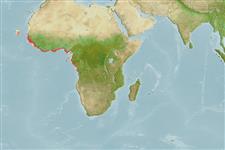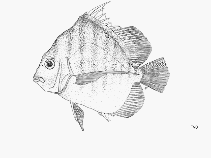Adicionar sua observação em Fish Watcher
| Native range | All suitable habitat | Point map | Year 2050 |

|
| This map was computer-generated and has not yet been reviewed. |
| Drepane africana AquaMaps Data sources: GBIF OBIS |
Carregue seu(sua) Fotos e vídeos
Pictures | Stamps, coins, misc. | Imagem do GoogleDrepane africana
Picture by FAO
Pictures | Stamps, coins, misc. | Imagem do GoogleDrepane africana
Picture by FAO
Common names from other countries
Classificação / Names Nomes comuns | Sinônimos | Catalog of Fishes(Gênero, Espécies) | ITIS | CoL | WoRMS | Cloffa
> Acanthuriformes (Surgeonfishes) > Drepaneidae (Sicklefishes)
Etymology: Drepane: Greek, drepane = sickle (Ref. 45335).
Etymology: Drepane: Greek, drepane = sickle (Ref. 45335).
Environment: milieu / climate zone / depth range / distribution range Ecologia
marinhas; estuarina bentopelágico; intervalo de profundidade 10 - 75 m (Ref. 27000), usually 20 - 50 m (Ref. 81287). Tropical; 30°N - 17°S, 27°W - 13°E
Distribuição Países | Áreas da FAO | Ecossistemas | Ocorrências | Point map | Introduções | Faunafri
Eastern Atlantic: West African coast, from Senegal to Angola (Ref. 7350, 81287). Also reported from the Canary Islands, Cape Verde (Ref. 7350) and Mauritania (Ref. 5377).
Tamanho / Peso / Idade
Maturity: Lm ? range ? - ? cm
Max length : 45.0 cm TL macho/indeterminado; (Ref. 1380); common length : 30.0 cm TL macho/indeterminado; (Ref. 3609); peso máx. publicado: 750.00 g (Ref. 4883)
Max length : 45.0 cm TL macho/indeterminado; (Ref. 1380); common length : 30.0 cm TL macho/indeterminado; (Ref. 3609); peso máx. publicado: 750.00 g (Ref. 4883)
Descrição suscinta Chaves de identificação | Morfologia | Morfometria
Espinhos dorsais (total) : 8 - 9; Raios dorsais (total) : 17 - 18; Espinhos anais: 3; Raios anais : 20 - 21. Diagnosis: body deep and strongly compressed, its anterior profile very steep up to dorsal-fin origin, and strongly compressed; head small; snout short; mouth small, terminal, strongly protrusible, with fleshy lips; teeth slender and pointed, set in bands in upper jaw; roof of mouth toothless; dorsal fin deeply notched; 1st dorsal fin spine small, forward-pointing and visible only in young individuals; pectorals falcate, very long, their tips almost reaching to caudal-fin base; hind margin of caudal fin slightly rounded; pelvic fins thoracic; scales finely ctenoid, covering body, bases of dorsal and anal fins and head, except snout and preopercle; preopercular margin denticulate; lateral line strongly arched (Ref. 81287).
Coloration: silvery grey, darker on back, almost white on belly; sides with a series of 8 brown, more or less faded vertical bars, always more distinct in young individuals (Ref. 81287).
Neritic species (Ref. 7350). Essentially marine, often living in groups (Ref. 81287) over sandy and muddy bottoms (Ref. 2683), between 20 and 50 m depth, and entering coastal lagoons where sexual maturation begins (Ref. 81287). Feeds of fish eggs, benthic invertebrates and detritus (Ref. 28587).
Ciclo de vida ou comportamento de acasalamento Maturidade | Reprodução | Desova | Ovos | Fecundidade | Larvas
Referência principal
Upload your references | Referências | Coordenador | Colaboradores
Desoutter, M., 1990. Ephippidae. p. 834-836. In J.C. Quero, J.C. Hureau, C. Karrer, A. Post and L. Saldanha (eds.) Check-list of the fishes of the eastern tropical Atlantic (CLOFETA). JNICT, Lisbon; SEI, Paris; and UNESCO, Paris. Vol. 2. (Ref. 7350)
Status na Lista Vermelha da UICN (Ref. 130435: Version 2024-2)
Segura ou pouco preocupante (LC) ; Date assessed: 23 May 2012
Ameaça para os humanos
Harmless
Uso pelos humanos
Pescarias: pouco comercial
FAO(pescarias: produção; publication : search) | FishSource |
Mais informação
Population dynamics
Parâmetros de crescimento
Max. ages / sizes
Length-weight rel.
Length-length rel.
Frequências de comprimento
Conversão de massa
Recrutamento
Abundância
Parâmetros de crescimento
Max. ages / sizes
Length-weight rel.
Length-length rel.
Frequências de comprimento
Conversão de massa
Recrutamento
Abundância
Life cycle
Reprodução
Maturidade
Fecundidade
Desova
Spawning aggregations
Ovos
Desenvolvimento dos ovos
Larvas
Dinâmica larval
Reprodução
Maturidade
Fecundidade
Desova
Spawning aggregations
Ovos
Desenvolvimento dos ovos
Larvas
Dinâmica larval
Anatomy
Área branquial
Brain
Otolith
Área branquial
Brain
Otolith
Physiology
Body composition
Nutrients
Consumo de oxigênio
Tipo de natação
Velocidade de natação
Visual pigments
Fish sound
Diseases & Parasites
Toxicity (LC50s)
Body composition
Nutrients
Consumo de oxigênio
Tipo de natação
Velocidade de natação
Visual pigments
Fish sound
Diseases & Parasites
Toxicity (LC50s)
Genetics
Genética
Heterozygosity
Hereditariedade
Genética
Heterozygosity
Hereditariedade
Human related
Aquaculture systems
Perfis para aquacultura
Estirpes
Ciguatera cases
Stamps, coins, misc.
Aquaculture systems
Perfis para aquacultura
Estirpes
Ciguatera cases
Stamps, coins, misc.
Ferramentas
Livro eletrônico | Guia de campo | Ferramenta auxiliar de frequências de comprimento | Ferramenta sobre a história de vida | Mapa de pontos | Classification Tree
| Catch-MSY |
Relatórios especiais
Checar Manutenção em Aquário | Checar Planilhas de Fatos sobre as Espécies | Checar Planilhas de Fatos sobre Aquicultura
Baixar XML
Fontes da internet
Aquatic Commons | BHL | Cloffa | Websites from users | Checar Observador de Peixes (FishWatcher) | CISTI | Catalog of Fishes(Gênero, Espécies) | DiscoverLife | ECOTOX | Faunafri | Fishtrace | GenBank(genoma, nucleotídeo) | GloBI | GOBASE | | Google Books | Google Scholar | Google | IGFA World Record | MitoFish | Otolith Atlas of Taiwan Fishes | PubMed | Reef Life Survey | Scirus | SeaLifeBase | Árvore da vida | Wikipedia(Ir para, procura) | World Records Freshwater Fishing | Registro zoológico
Estimates based on models
Preferred temperature (Ref. 115969): 19.2 - 28, mean 26.1 (based on 132 cells).
Índice de diversidade filogenética (Ref. 82804): PD50 = 0.7500 [Uniqueness, from 0.5 = low to 2.0 = high].
Bayesian length-weight: a=0.01380 (0.00724 - 0.02632), b=2.98 (2.81 - 3.15), in cm Total Length, based on LWR estimates for this species & (Sub)family-body (Ref. 93245).
Nível Trófico (Ref. 69278): 3.1 ±0.41 se; based on food items.
Resiliência (Ref. 120179): médio(a), tempo mínimo de duplicação da população 1,4 - 4,4 anos (K=0.13-0.25).
Fishing Vulnerability (Ref. 59153): High vulnerability (56 of 100).




